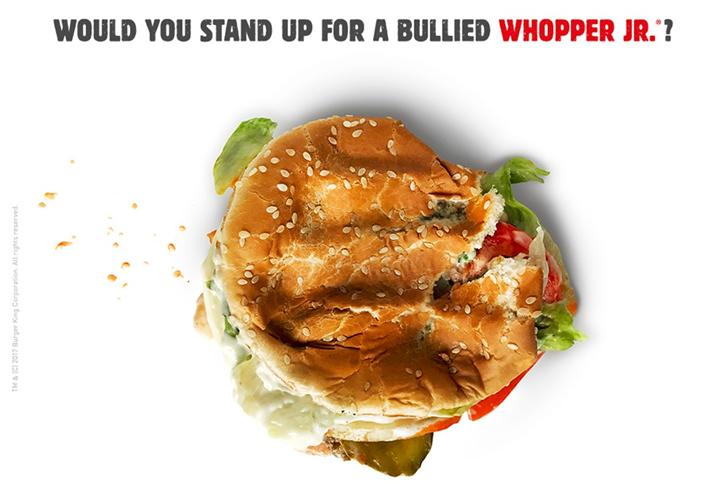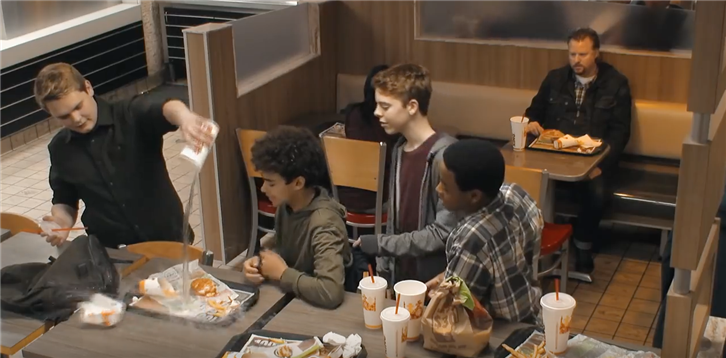
Imagine the two following scenarios, what would you do?
1. You witness a child being bullied in front of you. Do you step up to stop it, or pretend you haven’t seen anything, and slip away in fear of trouble?
2. In another situation, you bought a “bullied” hamburger, would you remain silent and accept it, or immediately talk to the store employee?
This social experiment by Burger King is meant to highlight the fact that bullying is being ignored in real life.
Rather than bore you with a speech, why not have you experience it for yourself?
Burger King installed hidden cameras to capture these two scenarios. One team of students will act out a bullying “live show”, while the customers in-store to witness the situation do not know that they are watching actors. The other team are actors who play store employees. If a Whopper Jr. burger is ordered, these actors will bully the burger by punching the defenseless burger, then wrap it and hand it over to the customer like nothing happened.

▲ How will you react if you see an act of bullying?
Of course, no one would think paying for a “bullied” burger is reasonable! The instant would be to talk to an employee, and a drama queen might even shout “I want to speak to your manager!”.

▲ No one would be happy to get a burger like this, right?
You go to counter and try to get things right. What you get is not a sincere apology from manager. Instead, the employee asks you “Did you order a bullied or not-bullied Whopper Jr.?” , or a “Yeah, I punched it. Is there a problem?”, would you get angry and confused?
If the employee asks you “Had you seen me bully this burger, would you have stood up and said something?”, and your answer is “Of course”, then it brings us to the question that Burger King want us to think about:
“If you cannot stand a burger being bullied, why would you ignore a child being bullied?”
So the question then becomes: Why would a fast food restaurant talk about anti-bullying that has nothing to do with its brilliant taste?
Before you think about this question, we have to talk about the two key influences of the digital era on products:
“Talk about what the customer cares about” and “Create a potential of sharing”
One of the advantages for brands in the digital era is the direct consumer communication through we media and social media. The communication barrier is significantly lowered, so that even a small-budget street vendor could compete with a luxurious 5-star hotel. However, the disadvantage is that everyone is a we media, and a brand competes with not only its competitors, but also contents from audience’s friends that includes everything in their lives. If the brand cannot produce something more attractive than a video someone falling on the ski slopes, why would anyone watch it online?
Brands used to talk about how great they are, and the amazing products they offer, but this model is increasingly harder to sell in the digital era. This is why Burger King is “talking about what the customer cares about”, to allure customers to stop and take a look. The reason that this story is told in this way, is to avoid people skipping brand ads and attract their attention online first, and then have a conversation.
The topic of “bullying” is an attempt to “solve a problem in the lives of the target consumer group” and form a closer relationship with the viewer. This proposal will create a dialog, and help the brand gain exposure and a chance to be shared.
The benefit of this method is that Burger King’s target group includes young students, and among the fast food brands, they are the only ones to listen to those who are bullied. If you relate to that sentiment, then even if you don’t spend money in Burger King, at least you won’t hate it.
The point is the key of resolving a customer’s issue. You are stepping into the customer’s shoes and not just from a product marketing point-of-view. This is quite a different concept from traditional marketing communications.
Now if Burger King still talks about a new product, and shows you another juicy burger ad, even if it looks tasty, you probably won’t “Give it a Like and Share”. Brands would then return to the dead-end street by investing huge money on mass media. The method is doable, but it will cost a lot, and a product ad has a different purpose from a brand image video, which, naturally, will result in different broadcast methods.
Take a look at the “Bullied Whopper Jr.” campaign again after you know about the two key ideas. Do you see it from a different level now?
